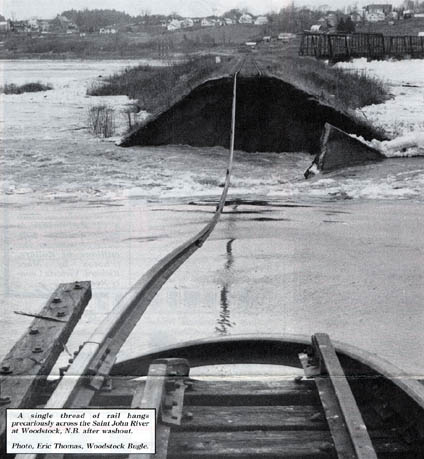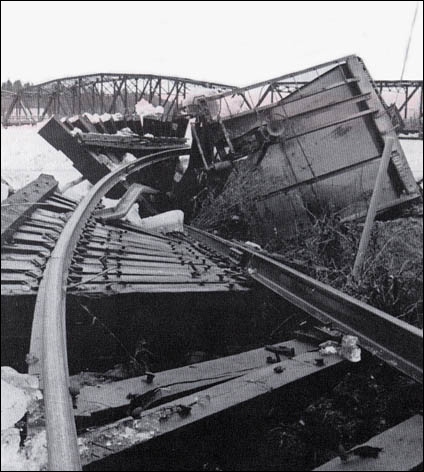Vol. 17 No. 6
June, 1987
|
Stay Safe in 87
|
|
Floods, Washouts, Plague
Eastern Operations
By Michel
Spenard

In April, CP Rail's Eastern Region got
a taste of just how powerful the forces of nature can be when ice-choked rivers in Quebec and New
Brunswick damaged three bridges and washed-out kilometres of track.
On the railway's Trois-Rivieres subdivision, the Riviere Sainte-Anne rose as much as three
metres April 1st, and when the ice jam broke, washed away three of the six through-truss spans crossing
at La Perade.
Two granite piers and the eastern abutment were destroyed by huge chunks of ice, some measuring as long as 15 metres
by three metres wide and five metres thick.
The strong current pushing the tonnes of ice and debris also claimed the pier supporting two of the remaining
trusses.
A victim of soil erosion, the pier sank into the river bed until the trusses' bottom cord had reached the water's
level.
Plans to remove each of the 270-tonne spans are being formulated, but will probably not proceed until
the river's water level drops to normal.
Traffic to Quebec City was re-routed over the St. Gabriel subdivision to Joliette and then on Canadian
National lines to Alenby, Quebec City.

Record high water and thousands of tonnes of ice slammed into a CP Rail bridge at
Perth Andover, N.B. Damage was in the millions of dollars.
At Perth Andover, N.B., seven steel
through-truss bridge spans with 17 loaded freight cars placed to give the bridge added weight against
the pressing ice jam, fell into the Saint John River 2 Apr 1987, while downstream at Woodstock, two
spans were washed away. Numerous washouts caused kilometres of track to be washed out.
The freight cars were loaded with a variety of products including chemical fertilizers, wood poles, and wrapping
paper. Two cars were empty.
The flood that caused the destruction of the Perth Andover and Woodstock bridges has been referred to as a
500-year event. The high waters and blocks of ice, some as large as cars, caused the evacuation of about
1,900 people, and caused millions of dollars in property damage.
There was some concern at first that the chemical fertilizers in the hopper cars - ammonium sulphate, diammonium
phosphate, and special granular potash, would be toxic to the river's fish population. The chemicals are not listed
as dangerous commodities.
Sample testing from two points downstream and a control location above the washout site showed that there was no
change in the water's chemical composition and there was nothing to indicate that the fish had been harmed.
Two teams of divers, one team using sonar, began underwater surveys as soon as the speed of the river's current
slowed to a safer level. At the flood's peak, it was estimated that the river was running at about 20 km/h, or, a
velocity of approximately 7,200-metric tons of water per second.
At Woodstock, N.B., two deck-plate spans were knocked off their piers, and approximately 75 metres of
fill and an abutment were washed away by ice and water. One steel span was located by sonar about 23 metres from its
original location.
The second span was found about 564 metres downstream with the help of eyewitness Weldon Trecartian of Upper
Woodstock.
"It looked like a whale breaching for air", he said. "The span was carried on the ice pack for some
time, when all of a sudden one end went under the ice. She then stood on end before sinking".
The day of the New Brunswick flood was 11 years and one day after the Saint John River flooded and caused substantial
damage to CP Rail trackage, with one washout causing the death of one employee and serious injuries to two others.
The 1976 flood eventually affected seven of 16 subdivisions and caused the closing of the Montreal-Saint
John main line.
This CP Rail News article is copyright
1987 by the Canadian Pacific Railway and is reprinted here with
their permission. All photographs, logos, and trademarks are the property of the Canadian Pacific Railway
Company.
|